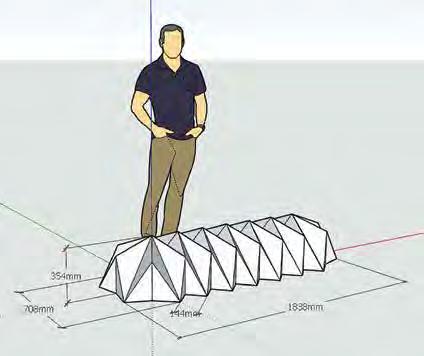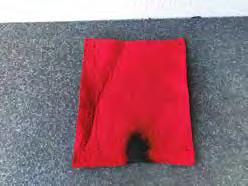
9 minute read
An origami-inspired fire shelter
The combination of fire-resistant materials and the centuries-old practice of origami may protect people during a bushfire emergency.
BY RICKY W K CHAN
School of Engineering, RMIT University
he south-east of Australia is known to be one of the most
Thazardous bushfire regions in the world. The volatile mix of climate, geography and vegetation can easily lead to bushfires, and CSIRO research indicates that the increasingly warmer and drier climate caused by climate change will make them more prevalent.
During a bushfire, heat transfer occurs by a combination of convection (movements of hot air mass), conduction (heat travelling through material), and radiation (a form of electromagnetic wave). Of the three, radiation, which is measured in heat 2flux (in kW/m ), does not require a medium to transfer. It is the most dangerous aspect of a bushfire— research indicates that an unprotected person may feel pain at 140 metres from flames after one minute of exposure. At 55 m, the heat flux is fatal after a few minutes.
The best protection from radiant heat is distance. When that is not an option, a protective barrier will become the difference between life and death. When battling wildfires, US firefighters carr y a lightweight fire shelter they can deploy when needed. It is designed to reflect radiant heat and trap breathable air, but cannot withstand sustained contact with flames.
To overcome this, researchers at RMIT University have developed a protection system that can be used in an emergency. It is a fire-rated blanket that deploys like an origami-type structure that encloses a person on the ground. When it is not in use, it can be folded into a small bag that can be carried by hand. The research team at RMIT University is attempting to optimise the fire shelter to:
FIGURE 1. Yoshimura crease pattern.
1. facilitate deployment and enclosure of a person 2. increase stiffness of a fire-rated fabric to create creases 3. meet Australian Standards fire tests.
Origami structures
The word ‘origami’ comes from the Japanese ‘oru’ and ‘kami’, meaning ‘to fold’ and ‘paper’ respectively. It is a recreational art and involves folding a sheet of paper into shapes resembling objects and animals. Origami has become ver y complex, with some creations even involving kinetic movements. The fascinating shapes of origami have inspired artists, mathematicians, architects and engineers, and have often been applied in spatial design, robotics and medical devices.
The fire shelter presented in this article is inspired by the Yoshimura crease pattern (Miura & Tachi, 2010). The geometr y consists of repetitive pairs of triangles that form a diamond shape. By alternating ‘mountain’ and ‘valley’ folds, the Yoshimura crease pattern may collapse (‘buckle’, in engineering terms) when compressed (Hunt & Ario, 2005) and extend under tension. The basic pattern is illustrated in Figure 1. The geometr y is characterised by the apex angle (b), deployment angle (q), length



FIGURE 3. 3D representation of the origami fire shelter. FIGURE 4. Procedure A (left) and procedure B (right) to ISO 15025: 2016.


(L), span (S) and width (W). These parameters are related geometrically.
Researchers at RMIT University used the Yoshimura crease pattern to design a shelter that encloses a person lying on the ground. The lay-flat geometr y is shown in Figure 2 and a threedimensional representation is in Figure 3.
Selection of fire-rated fabric
The fabrication of the fire shelter began with selecting suitable fire-rated fabric. Three burn-over fire blankets (samples A, B and C) were sourced from the Australian market for evaluation. Fire tests were conducted at RMIT University in accordance with AS 4967:2019 Protective clothing for firefighters (AS 4967, 2019). AS 4967 refers to clauses in procedures A and B in ISO15025:2016 (ISO15025, 2016).
These tests aim to verify a fabric’s ability to protect a person against flame and limit fire spread. Specimens measuring 200 x 160 millimetres were cut from the blankets and secured on a metal frame. They were subjected to direct flame positioned 20 mm away for 10 seconds. The flame was produced by commercial grade propane, as shown in Figure 4. One of the three samples did not pass the fire test. Specimens from Sample C at the end of the fire tests are shown in Figures 5 and 6.


Fabrication of the shelter
Thickness and texture were compared and Sample C was selected as the base material for the fabrication of an origami fire shelter. However, the original fabric was soft and lacked the stiffness required to create creases. Several strategies to overcome this were tried, including inserting steel wires and sewing on thin pieces of plastic sheets. Eventually, heat-stabilised interfacing fabric was found to produce satisfactor y results. Three layers of such interfacing materials were attached, with the middle layers corresponding to the triangular shapes shown in Figure 2. Since the interfacing fabric was not fire-rated, fire tests were repeated, and showed that the fire blanket material had sufficient thickness to prevent the interfacing material from melting. The final prototype, shown in Figure 7(a)–(c), can be folded and stored in a small bag for easy transportation. It is self-supporting and easy to deploy, and encloses a person lying on the ground. In total, the shelter (excluding the carr y bag) weighed 2.2kg.
Conclusion and future works
Origami produces many artistically pleasing and fascinating structures and has inspired many practical applications. The origami-inspired fire shelter developed by a team of researchers at RMIT University makes use of the Yoshimura crease pattern to create a collapsible shelter by alternating ‘mountain’ and ‘valley’ triangular folds and using a commercially available fire blanket. Compared with existing fire

FIGURE 7. Origami fire shelter (a) stored;(b) collapsed.

shelters, the origami fire shelter : ◆ can be deployed rapidly ◆ will entrap more breathable air for the occupant ◆ will sustain direct contact with flames.
Research is ongoing and will evaluate the temperature inside the shelter when it is engulfed in flame and seek to reduce its overall weight and enhance its portability.
(a)
FIGURE 7. (c) deployed. (b)

(c)
R E F E R E N C E S A S 4 9 6 7 ( 2 019 ) . P r o t e c t i v e c l o t h i n g f o r f i r e f i g h t e r s — R e q u i r e m e n t s a n d t e s t m e t h o d s f o r p r o t e c t i v e c l o t h i n g u s e d f o r s t r u c t u r a l f i r e f i g h t i n g . H u n t , G W, & A r i o , I ( 2 0 0 5 ) . Tw i s t b u c k l i n g a n d t h e f o l d a b l e c y l i n d e r : a n e x e r c i s e i n o r i g a m i . I n t e r n a t i o n a l J o u r n a l o f N o n - l i n e a r M e c h a n i c s, 4 0 ( 6 ) , 8 3 3 – 8 4 3 . d o i : 10 .1016 / j . i j n o n l i n m e c . 2 0 0 4 . 0 8 . 011 I S O 15 0 2 5 ( 2 016 ) . P r o t e c t i v e c l o t h i n g — P r o t e c t i o n a g a i n s t f l a m e — M e t h o d o f t e s t f o r l i m i t e d f l a m e s p r e a d. M i u r a , K , & Ta c h i , T ( 2 010 ) . S y n t h e s i s o f R i g i d - Fo l d a b l e C y l i n d r i c a l Po l y h e d r a. Pa p e r p r e s e n t e d a t t h e S y m m e t r y : A r t a n d S c i e n c e , 8 t h C o n g r e s s a n d E x h i b i t i o n o f I n t e r n a t i o n a l S o c i e t y f o r t h e I n t e r d i s c i p l i n a r y S t u d y o f S y m m e t r y, G m u e n d , A u s t r i a .
NOTE: Australian and New Zealand fire ser vices do not use personal fire shelters for wildfire fighter sur vival. The need for fire shelters is greatly reduced and firefighter safety is increased if training and incident management is focused on avoiding entrapment situations in the first instance.
AFAC21-HalfPage-advert_Dec.qxp_Layout 1 14/12/20 1:04 pm Page 1 ACK N OW L E D G E M E N T T h e r e s e a r c h h a s b e e n f u n d e d b y t h e C l i m a t e C h a n g e I n n o v a t i o n G r a n t s , D e p a r t m e n t o f E n v i r o n m e n t , L a n d , Wa t e r a n d P l a n n i n g , V i c t o r i a n G o v e r n m e n t . T h i s f i n a n c i a l s u p p o r t i s g r a t e f u l l y a c k n o w l e d g e d .
Knowledge Centre Sponsor Lanyard Sponsor Welcome Function Sponsor Gala Dinner Sponsor Conference Delegate Satchel Sponsor Café Naming Sponsor










